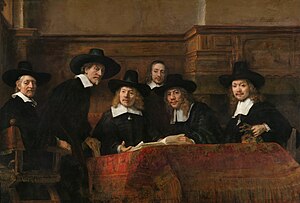You can help expand this article with text translated from the corresponding article in Dutch. (July 2020) Click [show] for important translation instructions.
|
| The Sampling Officials | |
|---|---|
| Dutch: De Staalmeesters | |
 | |
| Artist | Rembrandt |
| Year | 1662 |
| Medium | Oil on canvas |
| Movement | Baroque painting, Dutch Golden Age painting |
| Dimensions | 191.5 cm × 279 cm (75.4 in × 110 in) |
| Location | Rijksmuseum, Amsterdam |
The Sampling Officials (Dutch: De Staalmeesters), also called Syndics of the Drapers’ Guild (Dutch: De waardijns van het Amsterdamse lakenbereidersgilde), is a 1662 oil painting by Rembrandt. It is now in the Rijksmuseum in Amsterdam.[1] It has been described as his "last great collective portrait".[2]
The painting is a group portrait of five gentlemen from the Amsterdam cloth guild who were responsible for inspecting the cloth, along with their servant. They were not the regents of the guild but the wardens: two Catholics, a Mennonite, a Remonstrant, and a Reformed Protestant. Their one-year terms in office began on Good Friday and they were expected to conduct their inspections thrice weekly. It was an unpaid honorary position. To compare the quality of different batches of cloth, they used 'samples,' test pieces of fabric—hence their name, "staalmeesters" (masters of samples in Dutch). There were four grades of quality, the highest was indicated by pressing four seals and the lowest by pressing only one. The inspectors used pliers to press the seals of their city (front) and guild (reverse) into penny-sized slugs of lead that were specially affixed to record the results of the inspection.[3] They met three times a week. The aforementioned "staalmeesters" performed their duties from Good Friday 1661 to Good Friday 1662. Van Doeyenburg acted as the chairman of the group. The open book likely concerns the guild's accounting records. For a long time, it was thought that the man on the far right of the painting was holding a bag of stamps. During the restoration in 1991, it turned out to be a pair of gloves.[4]
The men, who are appraising a length of Persian-style fabric against exemplars from a swatch book, are (from left to right):
- Jacob van Loon (1595–1674)
- Volckert Jansz (1605 or 1610–1681)
- Willem van Doeyenburg (ca. 1616–1687)
- Frans Hendricksz Bel (1629–1701)
- Aernout van der Mye (ca.1625–1681)
- Jochem de Neve (1629–1681)
The guild commissioned this portrait and it hung in their guildhall, the Staalhof (nl), until 1771.
The painting is used on the packaging of Dutch Masters cigars. The painting is also seen on the wall in H. G. Wells' house in the opening sequence of The Time Machine. The painting has a prominent part in Jeffrey Archer's 2019 book "Nothing Ventured". It is used on the cover of the book titled 'The Company: A Short History of a Revolutionary Idea' by John Micklethwait and Adrian Wooldridge.[5] The painting plays an important role in Zadie Smith's book On Beauty, in which one of the main characters, Howard Belsey, is a Rembrandt scholar.
- ^ [1]. Rijksmuseum Amsterdam. Retrieved on 2008-05-03.
- ^ The Worldwide Art Gallery. "Rembrandt Harmenszoon van Rijn (1606 - 1669)". Theartgallery.com.au. Retrieved 2014-04-08.
- ^ Juran, Joseph M., ed. (1995), A History of Managing for Quality: The Evolution, Trends, and Future Directions of Managing for Quality, Milwaukee, Wisconsin: The American Society for Quality Control, p. 229, ISBN 9780873893411, OCLC 32394752
- ^ Ageeth Scherphuis, Tegenover een schilderij moet je je bescheiden gedragen, in: Vrij Nederland, 7 december 1991, p. 50
- ^ Micklethwait, John; Wooldridge, Adrian (11 January 2005). The Company: A Short History of a Revolutionary Idea. Random House Publishing. ISBN 9780812972870.